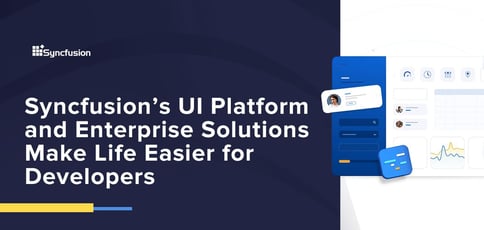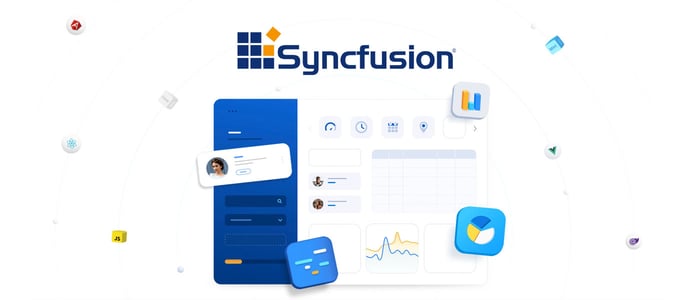
TL; DR: Syncfusion, founded by software development experts in 2001, provides a wide range of the enterprise-grade components and tools needed to meet evolving development needs. The suite helps developers deliver real business value through sleek user interfaces, straightforward business intelligence dashboards, and sophisticated reporting. Through a commitment to post-sale customer support and plans to build controls for upcoming frameworks, Syncfusion will continue to help app and site-building teams by addressing their rapidly changing needs.
With a shortage of skilled workers across the globe, tech talent is not only expensive but difficult to obtain.
According to a recent Korn Ferry report, more than 85 million jobs worldwide could go unfilled by 2030 simply because there aren’t enough skilled workers to hire. If this shortage persists in the tech industry alone, researchers estimate the U.S. could lose out on $162 billion worth of revenue per year.
Fortunately, one software provider is working to help companies of all sizes solve the tech talent problem before it spirals out of control.
“When a business application is being built, we believe that about 85% of the actual core can be built using licensed or open-source code,” said Daniel Jebaraj, CEO of Syncfusion. “However, developers need to be wary of code that has not gone through a proper vetting process.”

Daniel Jebaraj, CEO, discussed how Syncfusion can save app and site-building teams precious time.
Syncfusion’s repository of more than 1,600 components and controls quickly eliminates such concerns. The tools are designed to meet evolving development needs, whether the developer is working in Windows Forms, WPF, ASP.NET, ASP.NET MVC, JavaScript, or Xamarin, among other frameworks.
“Chances are that users will be able to get the majority of their needs met within our codebase, which allows them to minimize intellectual property (IP) risk,” Daniel told us. “Having a stocked toolbox also empowers them to respond to demand in a more agile way, getting products to market faster.”
Ultimately, by streamlining workflows and boosting productivity, Syncfusion empowers businesses to achieve their goals with fewer — and less stressed — developers.
The Initial Mission: Helping Users Quickly Deliver .NET Software
Syncfusion got its start in 2001 when Java was the go-to software platform for new development.
“A lot of the existing code was written in C and C++ back then, especially on Windows and Unix. But Java was becoming dominant as the first major managed platform, and there was a lot of interest, particularly among larger companies.”
By late 2000, Microsoft began releasing beta versions of .NET.
“We saw a lot of promise in .NET as a platform, especially for desktop development,” Daniel said. “Windows Forms was the framework that they were putting out at that time, and ASP.NET Web Forms was also coming out. So we chose to focus on Windows Forms because our interest at the time was desktop development.”

Syncfusion provides controls and frameworks that can be used to develop stunning applications.
The company’s initial mission was to help customers deliver .NET software quickly. It first achieved this goal through software for grid, chart, and editor controls.
“We started there and then grew that piece of offering and also expanded into different platforms,” Daniel said. “So while our original mission was to deliver desktop software quickly, we now provide high-quality software that adds great business value to enterprises, helping them work diligently for the success of every customer.”
Today, Syncfusion provides more than 1,600 UI components with a specialization in .NET, web, and mobile resources. These include native Blazor and Xamarin, plus tools for Angular, React, and Vue. Using these tools, developers can move beyond monotonous coding tasks to deliver sophisticated and innovative business software.
Staying Ahead in a Rapidly Evolving Dev Ecosystem
Over the years, Syncfusion has remained competitive by keeping up with emerging frameworks, tools, and platforms while maintaining support for older ones.
“Things change at a very fast pace in our market,” Daniel told us. “There was a focus on desktop development in the beginning, then mobile development with different frameworks within that space and so forth. At the same time, we also see many customers with long-running applications that are mission-critical. So we have that contrast.”
This means the Syncfusion team must plan for the future when it begins working with new platforms. “We have to be prepared for the long haul because customers who invest in those platforms depend on us to be around,” Daniel said. “They look to us to provide the tools and frameworks that are needed to maintain those products for many years.”
Of course, the company must also adapt to rapid change. Daniel told us he has recently noticed a growing trend in the availability and use of package managers, such as npm for JavaScript developers.

The company specializes in components and frameworks for enterprise software built in .NET, web, and mobile.
“This has a real impact on us because we may not necessarily get a chance to offer an evaluation to customers,” he said. “The traditional model was you went to the vendor’s website and provided some information to download the product. Then the vendor could reach out, give you information, set up a demo to walk you through the salient features of the product, and so forth.”
Without such an opportunity, it’s harder to get in front of potential customers before they make a purchasing decision. And, since the Syncfusion team publishes packages through resources like the npm Registry and NuGet Gallery, Daniel said the team doesn’t have much information on who is downloading the company’s software.
“The product has to speak for itself in this environment, so we offer a mode for self-driven evaluation,” he said. “Customers can take their time looking at the product because we have centralized locations on the web where they can find sample code.”
A Commitment to Excellent Ongoing Support
The Syncfusion developer platform has an impressive set of products, from web, desktop, and mobile controls to licensing management and access to quarterly releases. But Daniel told us his favorite aspect of the service is its robust support.
“I am proud of the extent and diligence with which we pursue post-sale support,” he said. “Syncfusion is unique in that it changes how you are building your product, and we want to influence the entire life cycle. Our goal is to ensure customers are satisfied with the service that they’re getting — not only through the evaluation process but also for many years as we support the product and help them to navigate the challenges within their market.”
The Syncfusion team also strives to reach out to its audience in a way that works for them. And with app and site-building teams, interactive ads don’t cut it. That’s why the company began publishing the “Succinctly Series,” a collection of nearly 200 free ebooks on essential technical information and ongoing industry trends.
“Providing this content has helped us connect with not just people who are looking to be our customers, but the larger ecosystem in which we operate as a company,” Daniel said. “Whether they choose to evaluate our products now or five years in the future doesn’t matter. We just want to stay connected to them, offer value, and thereby earn a seat at the table when they do make that decision.”
Besides serving as community thought-leaders, Syncfusion works to contribute to global movements such as Girl Develop It and community outreach groups like the Food Bank of Central and Eastern North Carolina.
Up Ahead: New Frameworks and Product Lines
The Syncfusion team has several plans in the works to provide additional value to application and site-building teams throughout 2021 and beyond.
“We’re particularly excited about the new frameworks taking root, especially the .NET MAUI framework that’s due out later this year,” Daniel said. “ We see it as a solid attempt by Microsoft to offer a truly cross-platform UI framework. We are looking forward to building controls for it and participating in that system starting from day one.”
The team has also been actively working on its enterprise-grade line of Bold products, which currently include products for business intelligence and analytics, digital signage, and reporting.
“The Bold lineup differs from the core Syncfusion products in that the building blocks are much larger. For example, we license a full reporting solution through Bold Reports. Replicating all of these solutions would take a typical company years of active development and discovery. Now, they can simply integrate complete frameworks into their systems.
HostingAdvice.com is a free online resource that offers valuable content and comparison services to users. To keep this resource 100% free, we receive compensation from many of the offers listed on the site. Along with key review factors, this compensation may impact how and where products appear across the site (including, for example, the order in which they appear). HostingAdvice.com does not include the entire universe of available offers. Editorial opinions expressed on the site are strictly our own and are not provided, endorsed, or approved by advertisers.
Our site is committed to publishing independent, accurate content guided by strict editorial guidelines. Before articles and reviews are published on our site, they undergo a thorough review process performed by a team of independent editors and subject-matter experts to ensure the content’s accuracy, timeliness, and impartiality. Our editorial team is separate and independent of our site’s advertisers, and the opinions they express on our site are their own. To read more about our team members and their editorial backgrounds, please visit our site’s About page.

